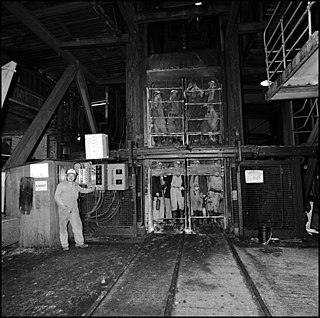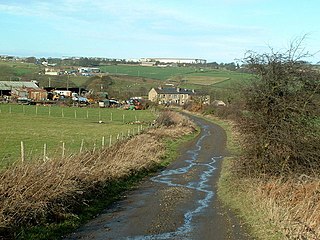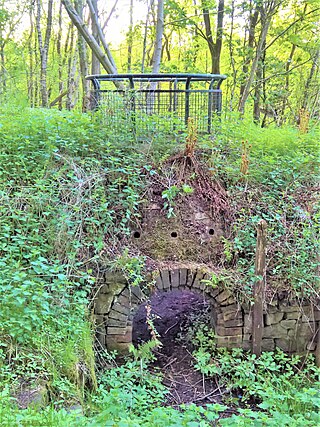
Seaham is a seaside town in County Durham, England. Located on the Durham Coast, Seaham is situated 6 miles south of Sunderland and 13 miles (21 km) east of Durham. The town grew from the late 19th century onwards as a result of investments in its harbour and coal mines. The town is twinned with the German town of Gerlingen.

Easington was, from 1974 to 2009, a local government district in eastern County Durham, England. It contained the settlements of Easington, Seaham, Peterlee, Murton, Horden, Blackhall, Wingate and Castle Eden. It did not however include Easington Lane which is administered as part of the City of Sunderland.

Croxdale is a village in the civil parish of Croxdale and Hett, situated about 3 miles (4.8 km) south of Durham City, in County Durham, England and on the A167 road, formerly part of the Great North Road. It is on the route of the East Coast Main Line and at one time had a station. The railway crosses over Croxdale Viaduct, built in 1872, just north of the village. The Weardale Way long distance footpath passes through the nearby Croxdale Hall estate.

Dawdon is a former pit community to the south of Seaham, County Durham, England. An area of the beach near Dawdon was used in the opening scenes of the science fiction film Alien 3.
Murton is a village in County Durham, England, eight miles (13 km) east of the city of Durham and six miles (9.7 km) south of Sunderland. It had a population of 4,534, which rose to 7,676 at the 2011 Census.

Leadgate is a village in County Durham, in England. It is situated to the north-east of Consett. The Roman road Dere Street runs straight through the middle of Leadgate, today this is known as Durham Road and the B6309.

Great Lumley is a village in County Durham, England. It is situated south east of Chester-le-Street, near Lumley Castle. It has a population of 3,843, reducing to 3,684 at the 2011 census.

Easington is a constituency created in 1950 represented in the House of Commons of the UK Parliament since 2010 by Grahame Morris of the Labour Party.

Caphouse Colliery, originally known as Overton Colliery, was a coal mine in Overton, near Wakefield, West Yorkshire, England. It was situated on the Denby Grange estate owned by the Lister Kaye family, and was worked from the 18th century until 1985. It reopened as the Yorkshire Mining Museum in 1988, and is now the National Coal Mining Museum for England.

Seaham is a railway station on the Durham Coast Line, which runs between Newcastle and Middlesbrough via Hartlepool. The station, situated 5 miles 11 chains (8.3 km) south-east of Sunderland, serves the seaside town of Seaham in County Durham, England. It is owned by Network Rail and managed by Northern Trains.

The Hetton colliery railway was an 8-mile (13 km) long private railway opened in 1822 by the Hetton Coal Company at Hetton-le-Hole, County Durham, England. The Hetton was the first railway to be designed from the start to be operated without animal power, as well as being the first entirely new line to be developed by the pioneering railway engineer George Stephenson.
Matthias Dunn was a British mining engineer and one of the first government inspectors of mines. He was known for encouraging safe practices in mines.

John Buddle was a prominent self-made mining engineer and entrepreneur in North East England. He had a major influence on the development of the Northern Coalfield in the first half of the 19th century, contributing to the safety of mining coal by innovations such as the introduction of the Davy Lamp, the keeping of records of ventilation, and the prevention of flooding. He was also interested in shipping as an owner, and built Seaham Harbour, establishing an important trade dock. He was chairman of the company that built the Tyne Dock at South Shields, and was also involved in the creation of two harbours and the development of a tunnel.

Monkwearmouth Colliery was a major North Sea coal mine located on the north bank of the River Wear, located in Sunderland. It was the largest mine in Sunderland and one of the most important in County Durham in northeast England. First opened in 1835 and in spite of the many accidents at the pit, the mine was the last to remain operating in the County Durham Coalfield. The last shift left the pit on 10 December 1993, ending over 80 years of commercial coal mining in the region. The Colliery site was cleared soon afterwards, and the Stadium of Light, the stadium of Sunderland A.F.C., was built over it, opening in July 1997 to replace nearby Roker Park.
Mosley Common Colliery was a coal mine originally owned by the Bridgewater Trustees operating on the Manchester Coalfield after 1866 in Mosley Common, Greater Manchester, then in the historic county of Lancashire, England. The colliery eventually had five shafts and became the largest colliery on the Lancashire Coalfield with access to around 270 million tons of coal under the Permian rocks to the south.

Whitburn Colliery was a coal mine located about three miles south of South Shields, North East England, located on the North Sea coast.

The 2nd (Seaham) Durham Artillery Volunteer Corps was a part-time unit of Britain's Royal Artillery raised in County Durham by the Vane-Tempest family during an invasion crisis in 1860. It became a permanent part of the Volunteer Force and later the Territorial Force, and fought as field artillery on the Western Front in World War I. Before World War II it became an anti-aircraft unit that served in the Battle of Britain, the Blitz and in the Far East where it converted to medium artillery in the Burma Campaign. Postwar, it continued to serve in the air defence role in the Territorial Army until 1955.

Shuttle Eye Colliery was a coal mine on the West Yorkshire Coalfield at Grange Moor between Wakefield and Huddersfield on the A642 road, in England.

The Burnley Coalfield is the most northerly portion of the Lancashire Coalfield. Surrounding Burnley, Nelson, Blackburn and Accrington, it is separated from the larger southern part by an area of Millstone Grit that forms the Rossendale anticline. Occupying a syncline, it stretches from Blackburn past Colne to the Yorkshire border where its eastern flank is the Pennine anticline.

Towneley Colliery or Towneley Desmesne was a coal mine on the Burnley Coalfield in Burnley, Lancashire, England. Sunk in the late 1860s, it was linked to the Lancashire and Yorkshire Railway's Burnley to Todmorden line which became known as the Copy Pit route and, by tramway, to the Leeds and Liverpool Canal.